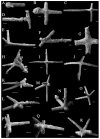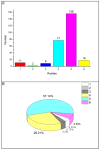Unraveling the Role of Spicules in Shaping Sponge Body Structure: Evidence from the Early Cambrian Shuijingtuo Formation
- PMID: 40723385
- PMCID: PMC12292252
- DOI: 10.3390/biology14070826
Unraveling the Role of Spicules in Shaping Sponge Body Structure: Evidence from the Early Cambrian Shuijingtuo Formation
Abstract
In most cases, sponge fossils are preserved as isolated spicules, with complete sponge body fossils largely confined to Konservat-Lagerstätten. Although the classification and diversity of sponges and their isolated spicules have been extensively studied, no systematic attempts have been made to define the relationship between fossil spicules and the sponge body plan. By utilizing relatively well-preserved sponge fossils from the black shales of the Shuijingtuo Formation (South China) in conjunction with isolated spicules from the same locality, we assess spicule morphology to identify the potential functional roles of spicules and chart their arrangement within the sponge body. The elemental distribution and three-dimensional morphology of the examined sponge body fossil (likely a hexactinelid) are assessed using both micro-XRF and micro-CT. Tetractine, stauractine and pentactine spicules are the most abundant spicule types, both in the body fossil and in acid residues, with an additional spicule type (monaxons) also present. The larger pentactine spicules (five-ray spicules) frame the structure, whereas the smaller tetractines and stauractines (four-ray spicules), along with smaller pentactines, are arranged along the branches of the larger spicules. Based on the arrangement of the different spicules, it is proposed that each of the spicule types represents a discrete functional form: monaxons support the overall sponge body plan, pentactines construct the framework of the parietal gaps, and the smaller pentactines or tetractines stabilize the framework of the parietal gaps. These results provide a new understanding of sponge morphology, spicule function and the relationship between isolated fossil spicules and associated sponge body fossils.
Keywords: Cambrian; micro-CT; micro-XRF; spicules; sponge.
Conflict of interest statement
The authors declare no conflicts of interest.
Figures














References
-
- Walter M.R. The Biology of Reefs and Reef Organisms. Chicago University Press; Chicago, IL, USA: 2013. 410p. - DOI
-
- Yang J.Y., Ma H.D., Chen A.L., Hou X.G. A New Leptomitid Sponge from the Early Cambrian Chengjiang Biota. Geol. J. China Univ. 2019;25:480. doi: 10.16108/j.issn1006-7493.2018117. (In Chinese with English Abstract) - DOI
-
- Li L.X., Yan G.Z., Wei X., Gong F.Y., Oliver L., Wu R.C. Late Ordovician sponge spicules from the Yangtze Platform, South China: Biostratigraphical and palaeobiogeographical significance. J. Asian Earth Sci. 2025;277:106380. doi: 10.1016/j.jseaes.2024.106380. - DOI
-
- Zhao X., Li G.X. Early Cambrian Sponge Spicule Fossils from Zhenba County, Southern Shaanxi Province. Acta Micropalaeontologica Sin. 2006;23:281–294. (In Chinese with English Abstract)
Grants and funding
LinkOut - more resources
Full Text Sources

